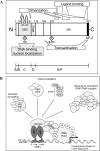Vitamin D and human health: lessons from vitamin D receptor null mice
- PMID: 18694980
- PMCID: PMC2583388
- DOI: 10.1210/er.2008-0004
Vitamin D and human health: lessons from vitamin D receptor null mice
Abstract
The vitamin D endocrine system is essential for calcium and bone homeostasis. The precise mode of action and the full spectrum of activities of the vitamin D hormone, 1,25-dihydroxyvitamin D [1,25-(OH)(2)D], can now be better evaluated by critical analysis of mice with engineered deletion of the vitamin D receptor (VDR). Absence of a functional VDR or the key activating enzyme, 25-OHD-1alpha-hydroxylase (CYP27B1), in mice creates a bone and growth plate phenotype that mimics humans with the same congenital disease or severe vitamin D deficiency. The intestine is the key target for the VDR because high calcium intake, or selective VDR rescue in the intestine, restores a normal bone and growth plate phenotype. The VDR is nearly ubiquitously expressed, and almost all cells respond to 1,25-(OH)(2)D exposure; about 3% of the mouse or human genome is regulated, directly and/or indirectly, by the vitamin D endocrine system, suggesting a more widespread function. VDR-deficient mice, but not vitamin D- or 1alpha-hydroxylase-deficient mice, and man develop total alopecia, indicating that the function of the VDR and its ligand is not fully overlapping. The immune system of VDR- or vitamin D-deficient mice is grossly normal but shows increased sensitivity to autoimmune diseases such as inflammatory bowel disease or type 1 diabetes after exposure to predisposing factors. VDR-deficient mice do not have a spontaneous increase in cancer but are more prone to oncogene- or chemocarcinogen-induced tumors. They also develop high renin hypertension, cardiac hypertrophy, and increased thrombogenicity. Vitamin D deficiency in humans is associated with increased prevalence of diseases, as predicted by the VDR null phenotype. Prospective vitamin D supplementation studies with multiple noncalcemic endpoints are needed to define the benefits of an optimal vitamin D status.
Figures











References
-
- Tausk M 1945 Driehonderd jaar rachitis onderzoek. De Engelsche ziekte in de geneeskunde voorheen en thans. 1645–1945. Uitgave der N.V. Organon-OSS
-
- Ebstein W 1908 Über das Vorkommen rachitischer Skelettveränderungen im Altertum und im Mittelalter. Virchows Archiv für pathologische Anatomie und Physiologie und für klinische Medizin (Berlin) 193:519
-
- Chick H, Palzell EJ, Hume EM 1923 Studies of rickets in Vienna 1919–1922. Special Report 77. Medical Research Council
-
- Hess A 1922 Influence of light on the prevention of rickets. Lancet 2:1222
-
- Huldshinsky K 1919 Heilung von Rachitis durch künstliche Höhensonne. Dtsch Med Wochenschr 45:712–713
Publication types
MeSH terms
Substances
Grants and funding
LinkOut - more resources
Full Text Sources
Other Literature Sources
Medical
Molecular Biology Databases

